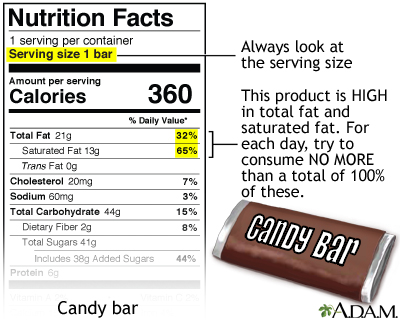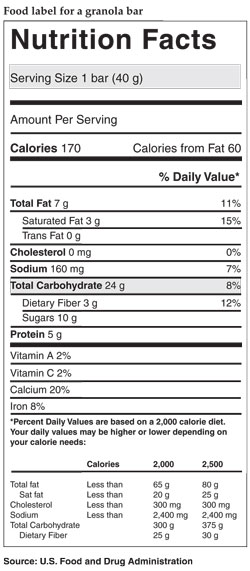40 how to read trans fats on food labels
Dietary fats explained: MedlinePlus Medical Encyclopedia Jul 13, 2020 · Experts are working to limit the amount of trans fats used in packaged foods and restaurants. You should avoid foods made with hydrogenated and partially hydrogenated oils (such as hard butter and margarine). They contain high levels of trans-fatty acids. It is important to read nutrition labels on foods. Understanding Food Labels - Fort HealthCare Trans fats are found mostly in processed foods made with partially hydrogenated oils. Even if the food label says '0 g trans fat', that doesn't necessarily mean it has no trans fat. It could have up to half a gram of trans fat per serving. So check the ingredient list for 'partially hydrogenated oils' - those are trans fats!
How To Read Food Labels, Whats Cooking America Sample Food Label on left: Always remember that the calories listed are based on one (1) individual serving from the container. 4 servings x 280 calories = 1,230 total calories in the container/box/bottle on the sample food label. Calories from fat - Food labels show Calories from Fat so you can limit the amount of fat you eat for a healthier ...

How to read trans fats on food labels
Food Labels (for Teens) - Nemours KidsHealth That's because they don't raise cholesterol levels like saturated fats and trans fats do. Both saturated and trans fats are considered "bad" because they can increase a person's chance of developing heart disease. Less than 10% of calories should come from saturated fats and try to keep trans fats as low as possible (less than 1%). Cholesterol Reading Food Labels (for Parents) - Nemours KidsHealth Saturated fats should account for less than 10% of the calories that kids eat each day. Trans fat should be as low as possible (less than 1% of total calories). Reading food labels - Heart Foundation Trans fat is often not listed on the nutrition information panel, which can make it hard to choose a healthy option. Avoid foods with 'partially hydrogenated' vegetable oil or vegetable fat, animal fat, copha, palm oil and coconut oil listed in the ingredients list. For example, it is advisable to limit intake of foods like bakery goods ...
How to read trans fats on food labels. Understanding Ingredients on Food Labels | American Heart ... Mar 06, 2017 · But when it comes to sodium, added sugars and saturated and trans fats – which in excess can damage your heart health and increase your risk of heart disease and stroke – it can be difficult to tell just how much is in there. The reason is, these ingredients can go by several names. There are many terms used for sugar on food labels. Food Label Ingredients: How to Look for MSG, Trans Fat ... Foods can call themselves "trans-fat free" even if they contain up to half a gram of trans fats per serving. Look on the ingredients list. If a food contains partially hydrogenated oils, it... How to Read a Nutrition Facts Label | Everyday Health For trans fats, nutrition labels are tricky. "The nutrition facts label can have 0 g listed next to trans fat, as long as the product has less than 0.5 g of trans fat per serving," says Goergen.... 3 Ways to Read Nutrition Facts on Food Labels - wikiHow Every number listed beneath "total fat" is calculated based on the amount contained in a single serving. So if the saturated fat on a label is listed at 6 grams but the number of servings is listed as 3, it means that there are a total of 18 grams of saturated fat in the container. [1]
Interpreting Total Fat and Types of Fat on Food Labels ... Determining the type of fat can help you decide whether or not a food is rich in 'healthy' and/or 'unhealthy' fats. Trans fats and, in some cases saturated fats, are considered "unhealthy" or "bad" while monounsaturated and polyunsaturated (omega-3) fats are generally healthier alternatives or "good" fats. Interactive Nutrition Facts Label - Food and Drug ... 4 servings per container Serving size 1 1/2 cup (208g) Amount Per Serving 240 Calories % Daily Value* 5% Total Fat 4g 8% Saturated Fat 1.5g Trans Fat 0g 2% Cholesterol 5mg 19% Sodium 430mg 17%... Easy Way to Tell if Food Has Trans Fats; Don't Trust Labels Ignore the Front of the Package; Read the Ingredients List Often, the ingredients are in super tiny print. Use a magnifying glass if you must. Often, the ingredients list is lengthy. Take the time to read every word! If the ingredients list contains the following items, the food has trans fats: "Partially hydrogenated" or just "hydrogenated." How to Understand and Use the Nutrition Facts Label | FDA It can tell you if a serving of food is high or low in a nutrient and whether a serving of the food contributes a lot, or a little, to your daily diet for each nutrient. Note: some nutrients on the...
PDF Food Label Tip: Choose Low Saturated Fat Trans Fat and ... trans fat, and cholesterol will raise your blood cholesterol level and increase your chances of developing heart disease. Compare food labels of similar products and choose the ones with the lowest % Daily Value* of saturated fat and cholesterol. In general, 5% or less is low. Twenty % or more is high. Also choose foods with no or low amounts of Easy Guide to Understanding Food Labels When You Have High ... This means that your food may contain trans-fat even if the food label says 0 gram. Therefore it's important to check the ingredient list (more on this later). Cholesterol guidelines currently recommend having not more than 300 milligrams of cholesterol per day, and if you have heart disease, aim for less than 200 milligrams per day. 2. Trans fatty acids - Food Standards Are trans fatty acids identified on food labels? Manufacturers are not required to declare TFAs on the label, although they can provide this information voluntarily. However, TFAs must be declared on a label if the manufacturer makes a nutrition content claim about cholesterol or saturated, trans, polyunsaturated, monounsaturated, omega-3 ... Understanding Food Nutrition Labels | American Heart ... 1 - Start with the serving information at the top. This will tell you the size of a single serving and the total number of servings per container (package). 2 - Next, check total calories per serving and container. Pay attention to the calories per serving and how many calories you're really consuming if you eat the whole package.
Trans Fats - American Heart Association Trans fats are easy to use, inexpensive to produce and last a long time. Trans fats give foods a desirable taste and texture. Many restaurants and fast-food outlets use trans fats to deep-fry foods because oils with trans fats can be used many times in commercial fryers.
FDA Trans Fat Labeling: What You Need to Know - LabelCalc According to the FDA, trans fats should appear as "Trans fat" or "Trans" on the nutrition facts panel on a separate line located directly underneath "Saturated fat.". Values for trans fats must appear in grams per serving. If the value for your product is under 5 grams per serving, then you must round it to the nearest 0.5 gram.
How to read food labels: MedlinePlus Medical Encyclopedia Look for foods that have no trans fats or are low in them (1 gram or less). Sodium is the main ingredient of salt. This number is important for people who are trying to get less salt in their diet. If a label says that a food has 100 mg of sodium, this means it has about 250 mg of salt. You should eat no more than 2,300 mg of sodium per day.
5 Ways to Avoid Hydrogenated Oil - Healthline Jul 31, 2018 · Some food labels claim no trans fats have been added, but partially hydrogenated oil may still be listed as one of the ingredients. So it’s important to read both the food label and the ...
How to Read Food Labels Without Being Tricked Reading labels can be tricky. Consumers are more health-conscious than ever, so some food manufacturers use misleading tricks to convince people to buy highly processed and unhealthy products.
How do I know if food contains trans fat? - Sharecare You can figure out if a food contains trans fat by doing a little detective work. On the information label, find the total fat content. Then, subtract the ...
What Are Trans Fats and How Do They Affect Your Health ... Even if a nutrition facts label lists trans fat grams as zero, the presence of partially hydrogenated oils tells a different story. If a food contains these oils, it means trans fats exist in small amounts — and, as explained above, small amounts matter. The only way to make sure a food is trans fat free is to read food labels.
7 Nutrition Label Ingredients to Avoid - Walker Methodist Partially Hydrogenated Oil is another form of trans-fat to watch out for on nutrition labels. This type of trans-fat is known to clog arteries and contribute to obesity and heart disease. High Fructose Corn Syrup (HFCS) High Fructose Corn Syrup is one of the most common food additives and has increased tremendously over the past 10-20 years.





Post a Comment for "40 how to read trans fats on food labels"